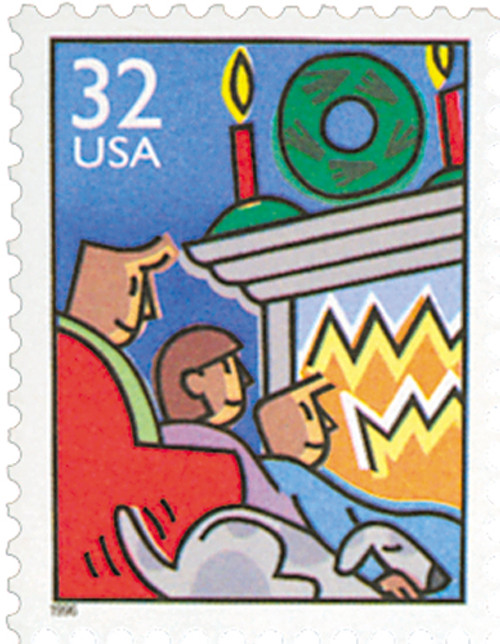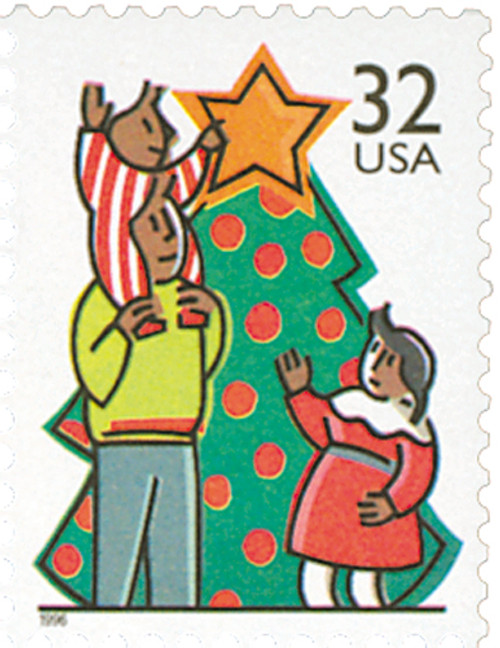
# 3110 FDC - 1996 32c Contemporary Christmas: Dreaming of Santa
US #3110
1996 Dreaming of Santa Claus
- Issued for the 1996 Holiday season
- Set of 4 picturing families celebrating Christmas
Stamp Category: Commemorative, Special stamp
Set: Christmas Family Scenes
Value: 32¢, First-Class Mail rate
First Day of Issue: October 8, 1996
First Day City: North Pole, Alaska
Quantity Issued: 56,489,000
Printed by: Ashton-Potter (USA) Ltd.
Printing Method: Lithographed and Engraved
Format: Panes of 50 from plates of 200
Perforations: 11.1 x 11.2
Why the stamp was issued: The set of four stamps was issued for use on mail sent during the 1996 holiday season.
About the stamp design: The stamps are the work of commercial artist, Julia Talcott. She cut colored paper to create the designs. The images were then scanned into a computer and touched up. Black lines were added to form outlines.
About the printing process: The stamps were issued as panes of 50 with water-activated gum and panes of 20 self-adhesive stamps. Each format was printed by a different company – Ashton-Potter (USA) Ltd. printed the larger panes, and Banknote Corporation of America produced the self-adhesive booklet.
First Day City: The First Day of Issue ceremony took place at the local high school in North Pole, Alaska, a town of about 700 people located near Fairbanks. A group of USPS officials flew there for the ceremony. Ted Stevens, a US Senator from Alaska spoke at the program. The Skaters stamps were dedicated at the same time.
About the Christmas Series:
By the early 1960s, the US Post Office was receiving 1,000 letters a year (for several years) asking for a Christmas-themed stamp to frank their holiday mail. The idea was approved and the US issued its first Christmas stamp on November 1, 1962.
The stamp was wildly popular, featuring popular holiday decorations of a wreath and candles. The Post Office Department had expected there would be a great demand for the issue, so they printed 350 million stamps – the largest print run for a special stamp up to that time. Those 350 million stamps sold out quickly, leading the Bureau of Engraving and Printing to produce more stamps – reaching over 860 million by the end of the year.
While the Christmas stamp was very popular, it wasn’t without its detractors. Some didn’t agree with the idea of the post office issuing a stamp honoring a religious holiday. Others wanted Christmas stamps that were more religious. The Post Office would continue to issue Christmas stamps in the coming years that featured the National Christmas Tree, seasonal plants, and an angel in 1965. The angel was considered less controversial because angels are included in many religions, not just Christianity.
In 1966, the Post Office came up with a plan to produce Christmas stamps utilizing classic paintings of the Madonna and Child. These stamps wouldn’t violate the separation of church and state because they were a celebration of culture. On November 1, 1966, they issued the first US Madonna and Child stamp in Christmas, Michigan. The stamp featured the 15th century painting, Madonna and Child with Angels, by Flemish painter Hans Memling.
That stamp was very popular and over 1.1 billion were printed. The same design was used again the following year, however, the 1967 stamp was larger and showed more of the painting. The stamp’s continued popularity led the Post Office to issue another traditional Christmas stamp in 1968, this time picturing the Angel Gabriel. For the 1969 issue, they reverted back to the non-religious theme, with a stamp picturing a painting called Winter Sunday in Norway, Maine.
The Post Office made a big change in 1970. To keep people in both camps happy, they issued one traditional Christmas stamp, picturing a classic painting of the Nativity, plus a block of four picturing Christmas toys. That decision proved popular and they have continued to issue stamps with both traditional and contemporary Christmas themes ever since.
History the stamp represents: The four scenes shown on the set of stamps are: a father, children, and dog in front of the fireplace, a father and children decorating a Christmas tree, a little girl dreaming about Santa’s arrival, and a mother and daughter returning from shopping.
US #3110
1996 Dreaming of Santa Claus
- Issued for the 1996 Holiday season
- Set of 4 picturing families celebrating Christmas
Stamp Category: Commemorative, Special stamp
Set: Christmas Family Scenes
Value: 32¢, First-Class Mail rate
First Day of Issue: October 8, 1996
First Day City: North Pole, Alaska
Quantity Issued: 56,489,000
Printed by: Ashton-Potter (USA) Ltd.
Printing Method: Lithographed and Engraved
Format: Panes of 50 from plates of 200
Perforations: 11.1 x 11.2
Why the stamp was issued: The set of four stamps was issued for use on mail sent during the 1996 holiday season.
About the stamp design: The stamps are the work of commercial artist, Julia Talcott. She cut colored paper to create the designs. The images were then scanned into a computer and touched up. Black lines were added to form outlines.
About the printing process: The stamps were issued as panes of 50 with water-activated gum and panes of 20 self-adhesive stamps. Each format was printed by a different company – Ashton-Potter (USA) Ltd. printed the larger panes, and Banknote Corporation of America produced the self-adhesive booklet.
First Day City: The First Day of Issue ceremony took place at the local high school in North Pole, Alaska, a town of about 700 people located near Fairbanks. A group of USPS officials flew there for the ceremony. Ted Stevens, a US Senator from Alaska spoke at the program. The Skaters stamps were dedicated at the same time.
About the Christmas Series:
By the early 1960s, the US Post Office was receiving 1,000 letters a year (for several years) asking for a Christmas-themed stamp to frank their holiday mail. The idea was approved and the US issued its first Christmas stamp on November 1, 1962.
The stamp was wildly popular, featuring popular holiday decorations of a wreath and candles. The Post Office Department had expected there would be a great demand for the issue, so they printed 350 million stamps – the largest print run for a special stamp up to that time. Those 350 million stamps sold out quickly, leading the Bureau of Engraving and Printing to produce more stamps – reaching over 860 million by the end of the year.
While the Christmas stamp was very popular, it wasn’t without its detractors. Some didn’t agree with the idea of the post office issuing a stamp honoring a religious holiday. Others wanted Christmas stamps that were more religious. The Post Office would continue to issue Christmas stamps in the coming years that featured the National Christmas Tree, seasonal plants, and an angel in 1965. The angel was considered less controversial because angels are included in many religions, not just Christianity.
In 1966, the Post Office came up with a plan to produce Christmas stamps utilizing classic paintings of the Madonna and Child. These stamps wouldn’t violate the separation of church and state because they were a celebration of culture. On November 1, 1966, they issued the first US Madonna and Child stamp in Christmas, Michigan. The stamp featured the 15th century painting, Madonna and Child with Angels, by Flemish painter Hans Memling.
That stamp was very popular and over 1.1 billion were printed. The same design was used again the following year, however, the 1967 stamp was larger and showed more of the painting. The stamp’s continued popularity led the Post Office to issue another traditional Christmas stamp in 1968, this time picturing the Angel Gabriel. For the 1969 issue, they reverted back to the non-religious theme, with a stamp picturing a painting called Winter Sunday in Norway, Maine.
The Post Office made a big change in 1970. To keep people in both camps happy, they issued one traditional Christmas stamp, picturing a classic painting of the Nativity, plus a block of four picturing Christmas toys. That decision proved popular and they have continued to issue stamps with both traditional and contemporary Christmas themes ever since.
History the stamp represents: The four scenes shown on the set of stamps are: a father, children, and dog in front of the fireplace, a father and children decorating a Christmas tree, a little girl dreaming about Santa’s arrival, and a mother and daughter returning from shopping.









